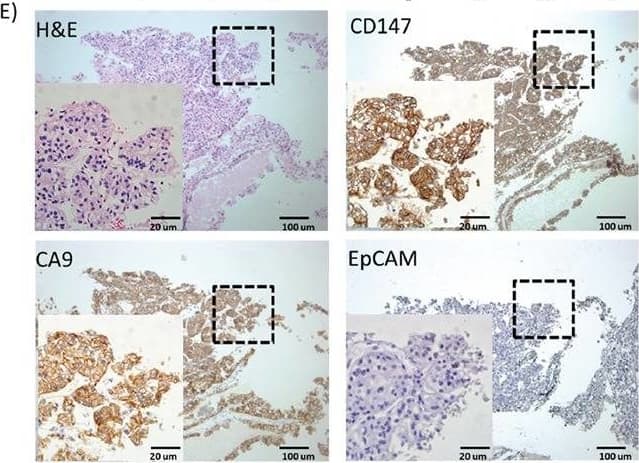Human EMMPRIN/CD147 Biotinylated Antibody
R&D Systems, part of Bio-Techne | Catalog # BAF972


Key Product Details
Species Reactivity
Validated:
Cited:
Applications
Validated:
Cited:
Label
Antibody Source
Product Specifications
Immunogen
Thr25-His205
Accession # Q54A51
Specificity
Clonality
Host
Isotype
Scientific Data Images for Human EMMPRIN/CD147 Biotinylated Antibody
Detection of Human EMMPRIN/CD147 by Immunohistochemistry
IHC analysis of EpCAM, CA9 and CD147 expression in RCC patient cohortA. Positive expression percentages of EpCAM, CA9 and CD147 in RCC patient samples of different clinical stages by IHC analysis (I, n=29; II, n=19; III, n=16; IV, n=6). B. IHC scores of EpCAM, CA9 and CD147 in RCC samples of (A). *** p<0.001. C. Positive expression percentages of CA9+ and/or CD147+ in EpCAM+ (I, n=8; II, n=3; III, n=1; IV, n=1) or EpCAM- (I, n=21; II, n=16; III, n=15; IV, n=5) RCC patient samples of different clinical stages by IHC analysis. D. IHC scores of EpCAM, CA9 and CD147 in RCC samples of (C). E. H&E and IHC staining of EpCAM, CA9 and CD147 in representative EpCAM- RCC patient tissues. The selected enlarged areas are indicated in dashed rectangles. Original magnification, 400× (enlarged) and 100× (original); scale bars: 20 μm (enlarged) and 100 μm (original). Image collected and cropped by CiteAb from the following publication (https://www.oncotarget.com/lookup/doi/10.18632/oncotarget.10979), licensed under a CC-BY license. Not internally tested by R&D Systems.Applications for Human EMMPRIN/CD147 Biotinylated Antibody
Western Blot
Sample: Recombinant Human EMMPRIN/CD147 Fc Chimera (Catalog # 972-EMN)
Reviewed Applications
Read 1 review rated 4 using BAF972 in the following applications:
Formulation, Preparation, and Storage
Purification
Reconstitution
Formulation
Shipping
Stability & Storage
- 12 months from date of receipt, -20 to -70 °C as supplied.
- 1 month, 2 to 8 °C under sterile conditions after reconstitution.
- 6 months, -20 to -70 °C under sterile conditions after reconstitution.
Background: EMMPRIN/CD147
EMMPRIN is expressed in areas of tissue remodeling, including tumors, endometrium, placenta, skin, and regions undergoing angiogenesis (1, 2, 6-9). It is also expressed in cells with high metabolic activity, such as lymphoblasts, macrophages and tumor cells (2, 10). On cells with elevated metabolic rates, EMMPRIN is often co-expressed with the amino acid transporter CD98h (11). EMMPRIN also interacts with caveolin-1 (via its C2-like domain), and this reduces the level of EMMPRIN glycosylation and subsequent EMMPRIN multimerization and activity (12). EMMPRIN’s TM sequence contains a Glu and a Pro which are important for intracellular interactions with cyclophilins (CyP) (3, 13, 14). CyPA (cyclosporin A receptor) and CyP60 interactions with the TM segment promote leukocyte inflammatory chemotaxis and surface expression of EMMPRIN, respectively (13, 14). An active 22 kDa fragment can be shed from tumor cells by MT1-MMP (1). Tumor cells can also release active, full-length EMMPRIN in microvesicles (15, 16). Functionally, EMMPRIN is known to induce urokinase-type plasminogen activator (uPA), VEGF, hyaluronan, and multiple MMPs (1, 2, 7, 8, 9). Human EMMPRIN (269 aa) shows 58%, 58%, 62%, and 52% aa identity with mouse, rat, bovine, and chicken EMMPRIN, respectively. It also shows 25% and 38% aa identity with the related proteins, embigin and neuroplastin (SDR-1), respectively (4).
References
- Gabison, E.E. et al. (2005) Biochimie 87:361.
- Yurchenko, V. et al. (2006) Immunology 117:301.
- Kasinrerk, W. et al. (1992) J. Immunol. 149:847.
- Miyauchi, T. et al. (1991) J. Biochem. 110:770.
- Hanna, S.M. et al. (2003) BMC Biochem. 4:17.
- Riethdorf, S. et al. (2006) Int. J. Cancer 119:1800.
- Braundmeier, A.G. et al. (2006) J. Clin. Endocrinol. Metab. 91:2358.
- Tang, Y. et al. (2006) Mol. Cancer Res. 4:371.
- Quemener, C. et al. (2007) Cancer Res. 67:9.
- Wilson, M.C. et al. (2005) J. Biol. Chem. 280:27213.
- Xu, D. and M.E. Hemler (2005) Mol. Cell. Proteomics 4:1061.
- Tang, W. et al. (2004) Mol. Biol. Cell 15:4043.
- Arora, K. et al. (2005) J. Immunol. 175:517.
- Pushkarsky, T. et al. (2005) J. Biol. Chem. 280:27866.
- Egawa, N. et al. (2006) J. Biol. Chem. 281:37576.
- Sidhu, S.S. et al. (2004) Oncogene 23:956.
Long Name
Alternate Names
Gene Symbol
UniProt
Additional EMMPRIN/CD147 Products
Product Documents for Human EMMPRIN/CD147 Biotinylated Antibody
Product Specific Notices for Human EMMPRIN/CD147 Biotinylated Antibody
For research use only